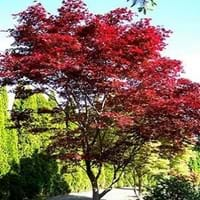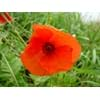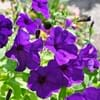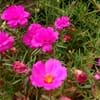Life Span
Annual
Perennial
Origin
Europe, Northern Africa, Central Asia, Western Asia
Eastern Asia
Types
Not available
Not Available
Habitat
Cultivated Beds
Forest margins, gardens, Suburban areas, Woods
USDA Hardiness Zone
4-8
6-8
Sunset Zone
A1, A2, A3, 1a, 1b, 2a, 2b, 3a, 3b, 4, 5, 6, 7, 8, 9, 10, 11, 12, 13, 14, 15, 16, 17, 18, 19, 20, 21, 22, 23, 24
A3, 2a, 2b, 3a, 3b, 4, 5, 6, 7, 8, 9, 10, 12, 14, 15, 16, 17, 18, 19, 20, 21, 22, 23, 24
Habit
Upright/Erect
Oval or Rounded
Flower Color
Red, Orange Red, Black
Red
Flower Color Modifier
Bicolor
Bicolor
Fruit Color
Sandy Brown, Chocolate
Red, Green, Brown
Leaf Color in Spring
Light Green, Gray Green
Burgundy, Dark Red
Leaf Color in Summer
Light Green, Gray Green
Burgundy, Dark Red
Leaf Color in Fall
Not Available
Red, Burgundy, Dark Red
Leaf Color in Winter
Light Green
Not Available
Leaf Shape
Pinnate
Maple shaped
Plant Season
Spring, Summer
Spring, Summer, Fall, Winter
Sunlight
Full Sun, Partial Sun
Partial Sun, Partial shade
Growth Rate
Very Fast
Slow
Type of Soil
Loam, Sand
Loam, Sand
The pH of Soil
Neutral
Acidic, Neutral, Alkaline
Soil Drainage
Well drained
Average
Bloom Time
Late Spring, Early Summer, Summer
Spring
Tolerances
Drought
Not Available
Where to Plant?
Container, Ground, Pot
Ground
How to Plant?
Seedlings
Grafting, Seedlings, Transplanting
Plant Maintenance
Medium
Medium
Watering Requirements
Keep ground moist, Keep the Soil well drained, Medium, Requires regular watering
Needs watering once a week, Requires watering in the growing season
In Summer
Lots of watering
Lots of watering
In Spring
Moderate
Moderate
In Winter
Average Water
Average Water
Soil pH
Alkaline, Neutral
Acidic, Neutral, Alkaline
Soil Type
Loam, Sand
Loam, Sand
Soil Drainage Capacity
Loam, Moist but well drained
Average
Sun Exposure
Full Sun
Partial Sun, Partial shade
Pruning
Remove damaged leaves, Remove dead branches, Remove dead leaves
Prune if you want to improve plant shape, Prune in winter, Prune to stimulate growth, Remove damaged leaves, Remove dead leaves, Remove deadheads
Fertilizers
All-Purpose Liquid Fertilizer
All-Purpose Liquid Fertilizer
Pests and Diseases
Adelgids, Downy mildew, Red blotch
Fungal Diseases
Plant Tolerance
Drought
Drought
Flowers
Showy
Insignificant
Flower Petal Number
Single
Single
Foliage Texture
Medium
Fine
Foliage Sheen
Matte
Matte
Attracts
Butterflies
Not Available
Allergy
Headache, Toxic if not prepared properly
Asthma
Aesthetic Uses
Beautification, Cut Flowers, Decorating walls, Hanging Basket, Showy Purposes, Used as an interior landscaping species, Used for decorating walls, fences, gates, hedges, etc.
Showy Purposes
Beauty Benefits
Not Available
Not Available
Environmental Uses
Air purification
Air purification
Medicinal Uses
Anodyne, Cancer, Emmenagogue, Emollient, Expectorant, Hypnotic, Sedative, Tonic
Sore Eyes
Part of Plant Used
Flowers, Leaves, Seeds
Bark, Sap
Other Uses
Cake, Cut Flowers, Decoration Purposes, Used for its medicinal properties, Used for making black and brown dye, Used in flavouring curries, teas, Used to flavour soups
Grown for shade, Used in Furniture, Used in making musical instruments
Used As Indoor Plant
Yes
No
Used As Outdoor Plant
Yes
Yes
Garden Design
Cottage garden, Cutflower, Flower borders, Hanging Basket, Showy Tree
Container, Feature Plant, Foundation, Mixed Border, Topiary / Bonsai / Espalier
Botanical Name
PAPAVER rhoeas
ACER palmatum 'Fireglow'
Common Name
Corn Poppy, Flanders Field Poppy, Shirley Poppy
Fireglow Japanese Maple, Japanese Maple
In Hindi
शर्ली अफीम
Fireglow मेपल
In German
Klatschmohn
Fireglow Maple
In French
shirley pavot
fireglow Maple
In Spanish
Shirley amapola
Fireglow arce
In Greek
Shirley παπαρούνας
Fireglow Maple
In Portuguese
Shirley poppy
Fireglow bordo
In Polish
Shirley maku
fireglow Klon
In Latin
Shirley, papaveris
Viridis Maple
Phylum
Tracheophyta
Angiosperms
Class
Magnoliopsida
Eudicotyledones
Order
Ranunculales
Sapindales
Family
Papaveraceae
Aceraceae
Clade
Angiosperms, Eudicots
Angiosperms, Eudicots
Tribe
Papavereae
Not Available
Subfamily
Paperveroideae
Amaryllidoideae
Importance of Shirley Poppy and Fireglow Maple
Want to have the most appropriate plant for your garden? You might want to know the importance of Shirley Poppy and Fireglow Maple. Basically, these two plants vary in many aspects. Compare Shirley Poppy and Fireglow Maple as they differ in many characteristics such as their life, care, benefits, facts, etc. Every gardener must at least have the slightest clue about the plants he wants to plant in his garden. Compare their benefits, which differ in many ways like facts and uses. The medicinal use of Shirley Poppy is Anodyne, Cancer, Emmenagogue, Emollient, Expectorant, Hypnotic, Sedative and Tonic whereas of Fireglow Maple is Sore Eyes. Shirley Poppy has beauty benefits as follows: Not Available while Fireglow Maple has beauty benefits as follows: Not Available.
Compare Facts of Shirley Poppy vs Fireglow Maple
How to choose the best garden plant for your garden depending upon its facts? Here garden plant comparison will help you to solve this query. Compare the facts of Shirley Poppy vs Fireglow Maple and know which one to choose. As garden plants have benefits and other uses, allergy is also a major drawback of plants for some people. Allergic reactions of Shirley Poppy are Headache and Toxic if not prepared properly whereas of Fireglow Maple have Asthma respectively. Having a fruit bearing plant in your garden can be a plus point of your garden. Shirley Poppy has no showy fruits and Fireglow Maple has no showy fruits. Also Shirley Poppy is not flowering and Fireglow Maple is not flowering . You can compare Shirley Poppy and Fireglow Maple facts and facts of other plants too.





